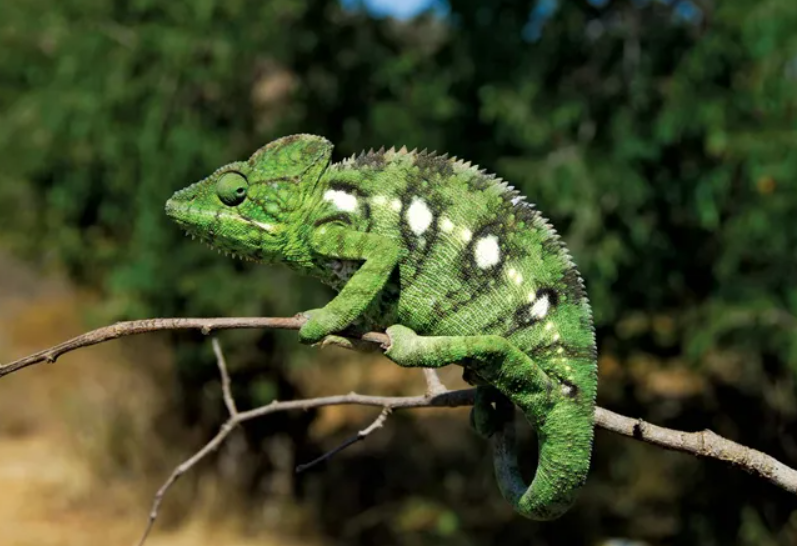Intriguing facts about chameleon, Brookesia Micra
The rare species of chameleon known as the nano-chameleon, or Brookesia micra, is exclusive to the island of Madagascar. Brookesia micra little reptile is among the smallest in the world when it comes to adult male chameleons, which reach a maximum length of roughly 29 millimetres. Brookesia micra has unique traits, and its small size makes it a very remarkable species.
Physical attributes of brookesia micra
Brookesia micra is distinguished from other chameleons by its physical attributes. Its shape is flattened to blend in with its environment, and its body is very thin and small. This chameleon also has a small, prehensile tail that aids in balance and movement. It can effectively blend in with its environment and evade predators because of its ability to change colour.
Uniqueness and significance of chameleon Brookesia Micra
For a little dog, the Brookesia Micra has a lot of interesting quirks. Like other chameleons, it can change the colour of its skin to fit in with its surroundings, providing it with excellent camouflage. This species is arboreal, meaning it spends most of its time in trees. It moves slowly and with purpose, using its special foot and tail to help it cling to plants and trees. The Brookesia Micra is well-known for its unusual hunting technique, which entails waiting for prey to reach its range by staying still for extended periods of time. Its methodical methodology allows it to accurately collect tiny insects and other animals.
Fascinating facts regarding of brookesia Micra
One of the tiniest reptiles on the planet is the Brookesia micra chameleon, often referred to as the dwarf chameleon. The following are some intriguing details regarding this amazing creature:
Incredible smallest size of chameleon: Brookesia Micra
Male, mature Brookesia micra chameleons grow to a maximum length of around one inch, making them very small animals. As a result, they rank among Earth’s tiniest vertebrates. Their prehensile tail, which helps them hold onto trees, small limbs, and slim body give them a distinctive look. They may have a variety of colours, but they usually have grey, green, and brown tones that help them blend in with their environment.
Habitat ranges or countries where Brookesia Micra Chameleon can be found
The Brookesia Micra Chameleon is originally from Madagascar, an island near Africa’s east coast. It is located on the tiny islet of Nosy Hara in the island’s northern region. This chameleon’s environment, low-lying coastal woodlands, requires it to be extremely specialised.
The behavioral characteristics of Brookesia Micra.
The Brookesia micra chameleon, like other chameleons, has the amazing ability to alter its colour to fit in with its surroundings. This allows it to ambush its prey and hide from predators. These chameleons have amazing camouflage qualities in addition to their ability to change colour. They are almost inconspicuous among the leaves and branches of their environment because of their tiny size and cryptic colouring.
Special adaptations that help it survive in its environment
Additionally, Brookesia micra chameleons have developed special environmental adaptations. They can search their environment for possible dangers or prey by moving their eyes independently. They are also skilled climbers because of their unique feet, which have little claws that help them hold onto objects.
Preferred food and eating patterns of Brookesia Micra Chameleon
Microscopic invertebrates such as mites and ants are the primary food source for these little chameleons. They capture their prey using their lengthy, sticky tongue. Because of their small size, they require a large number of insects to meet their energy needs. They are patient hunters, waiting to use their tongues to seize their prey until it is close enough to attack.
Mating and Reproductive process of Brookesia Micra
Reproduction in Brookesia micra chameleons is distinct. The female lays tiny clutches of eggs, often two to four, and buries them in the leaf litter on the forest floor. The hatchlings are completely autonomous from birth, and the eggs take many months to hatch.
longevity and lifespan of this fascinating creature: Brookesia Micra
These chameleons have a comparatively short lifetime, usually lasting two to three years. Because their life cycles are shorter and their metabolic rates are higher than those of larger species, tiny reptiles are frequently affected.
Continued research and conservation efforts are needed to ensure the survival of Brookesia Micra
The International Union for Conservation of Nature has designated the Brookesia micra chameleon as critically endangered (IUCN). Due to its tiny population and restricted distribution, it is very susceptible to habitat deterioration and loss. The removal of forests, especially for logging and agriculture, is a major danger to their existence. This species’ demise is further exacerbated by the illicit pet trade.
importance of understanding and conserving Brookesia Micra
In addition to spreading awareness of the Brookesia micra chameleon’s conservation concerns, efforts are being made to preserve the species’ remaining habitat. For this rare and amazing animal to survive, strict rules against the illicit wildlife trade and legislation protecting its habitat are essential.
Information that showcases the uniqueness of Brookesia Micra.
A fascinating species, the Brookesia micra chameleon is named for its unusual adaptations and small size. It’s an interesting organism to examine because of its ability to blend in with its environment and its unique eating habits. But in order to save this threatened species and guarantee its continued existence for future generations, immediate conservation action is required.

